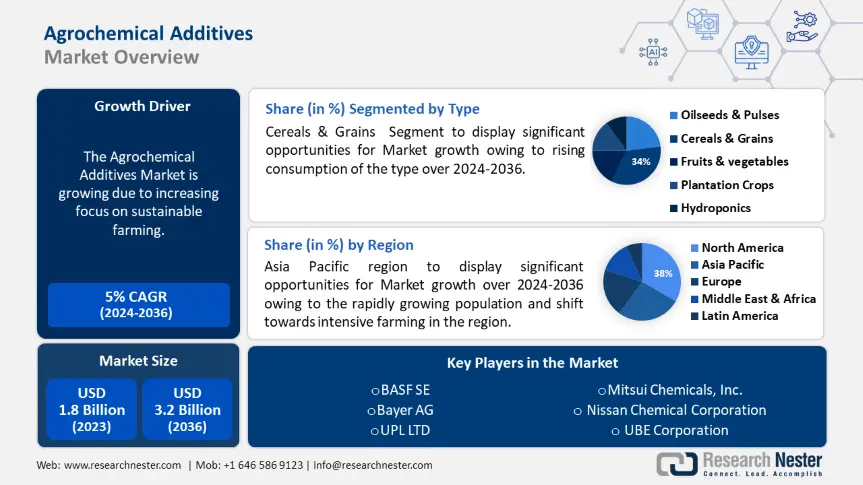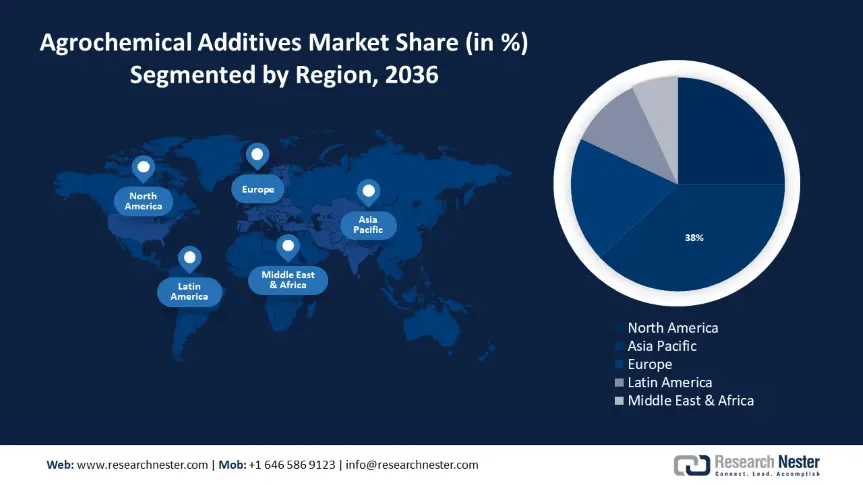
Agrochemical Additives Market size was over USD 1.8 Billion in 2023 and is estimated to reach USD 3.2 Billion by the end of 2036, growing at a CAGR 5% during the forecast period, i.e., 2024- 2036. In the year 2024, the industry size of agrochemical additives is valued at USD 1.89 Billion.
The increased need for packaged foods has expanded globally due to population growth, which has also raised demand for agricultural products and agrochemical additives. As observed by Research Nester analyst, U.S Processed Food Products exports in 2023 accounted for a value of around USD 36 Billion. The use of agricultural chemicals to increase crop yield has increased recently. The use of agrochemicals such as fertilizers and pesticides has become vital to meet the increasing demand for food. Agrochemicals are essential for improving plant growth, crop output, and crop quality as well as soil moisture.
Based on their types, agrochemicals are separated into groups such as insecticides, fertilizers, and pesticides. Fertilizers are widely utilized to boost fertility, crop yield, and output of agro goods owing to their capacity to increase the nutritional content of soil and crops. Further, the expansion of the agrochemical industry, fuelled by investments in research and development, is driving the growth of the agrochemical additives market. Manufacturers are developing innovative additives tailored to specific agrochemical formulations, thereby widening the market scope.

Growth Drivers
Challenges
|
Base Year |
2023 |
|
Forecast Year |
2024-2036 |
|
CAGR |
5% |
|
Base Year Market Size (2023) |
USD 1.8 Billion |
|
Forecast Year Market Size (2036) |
USD 3.2 Billion |
|
Regional Scope |
|
Crop Type (Oilseeds & Pulses, Cereals & Grains, Fruits & Vegetables, Plantation Crops Hydroponics)
Cereals & Grains segment is predicted to hold the majority market share by 2036, amounting to 34%. Agrochemical additives tailored for cereals & grains aim to enhance yield, protect against pests & diseases, and optimize nutrient absorption, catering to the essential nature of these crops in global food supply.
It was observed that critical minerals are added to fertilizers to boost rice crop output and grain nutrient content, which is anticipated to propel the demand for agrochemical additives. It was observed that FAO’s new projections for world cereal production in 2023 were slightly raised to 2,840 million tonnes and now stand at 30.4 million tonnes higher than the last year with a 1.1 per cent increase of 31.4 million tonnes.
Type (Fertilizers, Pesticides, Herbicides, Insecticides, Fungicides)
Fertilizers segment is expected to witness substantial growth over the forecast period. The need for food and agricultural products will likely increase due to population expansion, which will fuel the use of fertilizers in the agricultural sector. Government subsidies on some fertilizers are expected to help the fertilizers segment to remain a significant end-use in the market.
For cereals & grains, fertilizers including urea, ammonium nitrate, and anhydrous ammonia are recommended. Cereals & grains can be fertilized in three different methods. They can be sprayed on independently or combined with other fertilizers and given to seedlings. They can also be top-dressed separately. Increasing cereal & grain yields requires applying fertilizers at the right rate and in the right quantities. The production of the three main cereal crops—rice, wheat, and maize—uses around 60% of the nitrogen present in Earth's soil. All these factors cumulatively account for the segment growth in the market.
Our in-depth analysis of the global market includes the following segments:
|
Form |
|
|
Type |
|
|
Crop Type |
|
|
Application |
|
APAC Market Analysis
Asia Pacific agrochemical additives market for is poised to dominate 38% revenue share by the end of 2036. The region is home to a large and rapidly growing population, driving the demand for food & agricultural products. The production value of the agriculture industry in the region accumulated to around USD 2.1 trillion.
Agrochemical additives play a vital role in enhancing crop yields and quality to meet the food demand of growing urban populations. In response to increasing food demand and limited arable land availability, there is a shift towards intensive farming practices in the Asia Pacific region. Agrochemical additives are crucial in optimizing agricultural inputs and maximizing yields in intensive farming systems, fueling market growth.
The Asia Pacific region is witnessing a growing adoption of biotechnology in agriculture, including genetically modified (GM) crops. Agrochemical additives that support the performance of biotech-derived crop protection products, such as adjuvants for GM herbicide-tolerant crops, are experiencing increased demand, contributing to the agrochemical additives market expansion. Biotech crops were grown on 19.5 million hectares, or 10.2% of the world's biotech crop area, in nine countries in Asia Pacific in 2019: India, China, Pakistan, Philippines, Australia, Myanmar, Vietnam, Indonesia, and Bangladesh.
North American Market Statistics
North America agrochemical additives market is set to attain significant market share till 2036. The region experiences a consistent demand for crop protection products to sustain its large-scale agricultural operations. Agrochemical additives play a crucial role in enhancing the efficacy of pesticides, herbicides, and fungicides, thereby meeting the demand for higher yields and quality crops.
Also, environmental sustainability is a key concern driving market growth in North America. Agrochemical additives that offer eco-friendly solutions, such as bio-based adjuvants and biodegradable surfactants, are increasingly favored by farmers and regulators alike, contributing to market expansion.
Moreover, the rising consumer demand for organic produce has led to an expansion of organic produce has led to an expansion of organic farming practices in North America. In 2022, organic food sales in the U.S. reached USD 60 billion, making it one of the highest levels for a resilient organic sector.
Additionally, the US organic food market accounted for six percent of its overall sales during the year 2022. Agrochemical additives certified for use in organic agriculture, such as organic adjuvants and plant-based formulations, are witnessing growing demand, driving market development.



Author Credits: Shivam Bhutani, Anil Kumar
Copyright © 2024 Research Nester. All Rights Reserved

FREE Sample Copy includes market overview, growth trends, statistical charts & tables, forecast estimates, and much more.
Have questions before ordering this report?